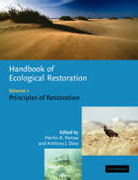
Handbook of ecological restoration v. 1 Principles of restoration
Perrow, Martin R.
Davy, Anthony J.
The two volumes of this handbook provide a comprehensive account of the emerging and vibrant science of the ecological restoration of both habitats and species. Ecological restoration aims to achieve complete structural and functional, self-maintaining biological integrity following disturbance. In practice, any theoretical model is modified by a number of economic, social and ecological constraints. Consequently, material that might be considered as rehabilitation, enhancement, re-construction or re-creation is also included. Principles of Restoration defines the underlying principles of restoration ecology, in relation to manipulations and management of the biological, geophysical and chemical framework. The accompanying volume, Restoration in Practice, provides details of state-of-the-art restoration practice in a range of biomes within terrestrial and aquatic ecosystems. The Handbook of Ecological Restoration will be an invaluable resource to anyone concerned with the restoration, rehabilitation, enhancement or creation of habitats in aquatic or terrestrial systems, throughout the world. INDICE: List of contributors; Foreword; Preface; Part I. The Background: 1. Introduction and philosophy Anthony D. Bradshaw; 2. Rationale for restoration John Cairns Jr; 3. The ecological context: a landscape perspective Richard J. Hobbs; 4. The ecological context: a species population perspective David W. MacDonald, Thomas P. Moorhouse and Jody W. Enck; 5. The evolutionary context: a species perspective Alan J. Gray; Part II. Manipulation of the Physical Environment: 6. Terrestrial systems Steve G. Whisenant; 7. Wetlands and still waters Jillian C. Labadz, David P. Butcher and Dennis Sinnott; 8. Running water: fluvial geomorphology and river restoration Malcolm D. Newson, John Pitlick andDavid A. Sear; Part III. Manipulation of the Chemical Environment: 9. Manipulating the chemical environment of the soil Robert H. Marrs; 10. Chemical treatment of water and sediments with special reference to lakes Martin SC8ndergaard, Klaus-Dieter Wolter and Wilhelm Ripl; 11. Atmospheric chemistry Peter Brimblecombe; Part IV. Manipulation of the Biota: 12. Establishment and manipulation of plant populations and communities in terrestrial systems Anthony J. Davy;13. Ecology and management of plants in aquatic ecosystems Stefan E. B. Weisner and John A. Strand; 14. Micro-organisms Michael F. Allen, David A. Jasper and John C. Zak; 15. Terrestrial invertebrates Jonathan D. Majer, Karl E. C. Brennan and Lubomir Bisevac; 16. Aquatic invertebrates John S. Richardson and Michael J. Jackson; 17. Fish Martin R. Perrow, Mark L. Tomlinson and Luis Zambrano; 18. Reptiles and amphibians Carl G. Jones; 19. Birds JosC) Maria Cardoso da Silva and Peter D. Vickery; 20. Mammals David W. MacDonald, Thomas P. Moorhouse, Jody W. Enck and Fran H. Tattersall; Part V. Monitoring and Appraisal: 21. Monitoring and appraisal Karen D. Holl and John Cairns Jr; Index.
- ISBN: 978-0-521-04983-2
- Editorial: Cambridge University
- Encuadernacion: Rústica
- Páginas: 460
- Fecha Publicación: 31/01/2008
- Nº Volúmenes: 1
- Idioma: Inglés
